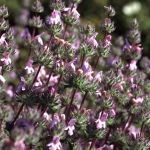| Common Name: |
Za'atar Rumi |
| Other Names: |
Thyme-Leaved Savory, Pink Savory, Roman Hyssop |
| Genus |
Satureja |
| Botanical Name: |
Satureja thymbra |
| Family: |
Lamiaceae |
| Native Location: |
E Mediterranean to the Balkans |
| Cultivation |
Well-drained to dry, neutral to alkaline soil in sun. Satureja douglasii needs moist, sandy, slightly acid loam, and partial shade. Pinch out new shoots in spring to encourage bushiness. Cut back perennials in early spring. Winter crops of S. hortensis may be grown in pots in greenhouses at 7-10°C (45-50°F) or from seed sown in early autumn; it reputedly deters Mexican bean beetles if planted along rows of legumes. |
| Propagation |
By seed sown in spring at 13-16°C (55-61°F); by division in autumn or spring (perennials); by greenwood cuttings in summer (shrubby species). |
| Harvest |
Leaves are harvested during the growing season. Flowering tops are picked in summer. Both are used fresh, or dried for infusions and oil extraction. |
| Height: |
40cm (16in) |
| Width: |
30-40cm (12-16in) |
| Hardiness |
Z8-9 |
| Parts Used: |
Leaves |
| Properties |
A pungent, aromatic herb that improves digestion,and has bactericidal and expectorant effects. It has thyme-like flavor. |
| Medicinal Uses: |
Internally, in folk medicine as a tea to relieve minor digestive discomfort and bronchial congestion. |
| Culinary Uses: |
Leaves are used to flavor meat dishes, grilled or barbecued meat, roasted vegetable dishes; also in a marinade for olives. An ingredient of the Middle Eastern spice mixture, za'atar. Dried leaves are used to make tea. Strong infusion is used to clean wine barrels in Crete. |
| Economic Uses: |
Oil, rich in carvacrol and thymol, is distilled from the leaves for the pharmaceutical industry. |
| Bibliography: |
Encyclopedia of Herbs by Deni Bown Copyright © 1995, 2001 Dorling Kindersley Limited. pp 361-362 |

